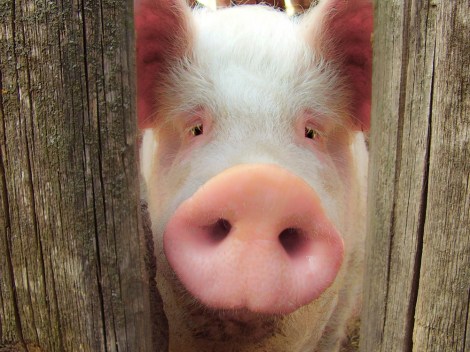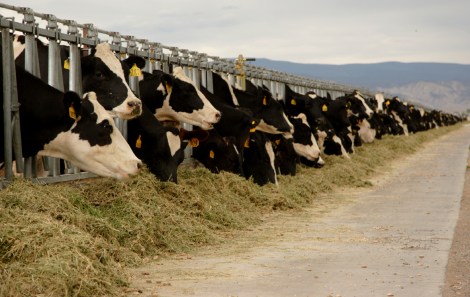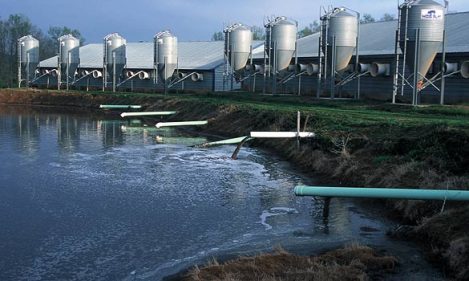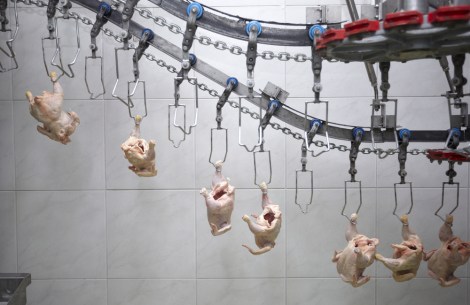
Photo by Shutterstock.
By now, you know that not all meat is created equal. That familiar fable about Old MacDonald and his happy barnyard menagerie is a far cry from the cruel reality of factory farms, where cows, pigs, and chickens are crammed together in giant warehouses, fattened on grain, and pumped full of antibiotics, then rolled out to the slaughterhouse to become the next Big Mac or box of McNuggets.
In regulatory lingo, these meat factories are called “concentrated animal feeding operations,” or CAFOs. (Pronounced “cay-fo.”) Here’s everything you ever wanted to know about them — and a few things you’d probably rather not know.
Q. What makes a CAFO a CAFO?
A. Most in the industry consider all factory farms CAFOs, but the Environmental Protection Agency (EPA) has a very specific meaning. According to the EPA, an Animal Feeding Operation (AFO) is an operation that confines animals for over 45 days in a vegetation-free area. These animals are packed into warehouses and lots with slatted floors, not wandering around in the grass. Here’s the EPA’s website: “AFOs congregate animals, feed, manure and urine, dead animals, and production operations on a small land area. Feed is brought to the animals rather than the animals grazing or otherwise seeking feed in pastures, fields, or on rangeland.”
CAFOs are essentially big AFOs. The EPA breaks CAFOs down [PDF] into large, medium, or small varieties, depending on the number of animals involved, how wastewater and/or manure are managed, and whether the operation is “a significant contributor of pollutants.” Large CAFOs, which have at least 1,000 cows or 30,000 hens, are automatically subject to government oversight.
Here’s what one of those looks like:
Q. How much of the meat we eat is CAFO-raised?
A. It’s hard to say exactly. Despite their growing presence in this country, CAFOs are invisible to most of us. If you live in an urban or suburban part of the country, most livestock — save the occasional decorative cow or sheep — is kept out of sight. But if you’ve driven through California on Interstate 5, you may have seen and smelled the giant feedlot known as Cowschwitz. There are CAFOs in just about every state, but the Southeast and the Midwest — Iowa has an especially high number — are where you’ll find them in the highest concentration.
In case you missed it, it looks like this:

Photo by istock.
The exact number of CAFOs in this country is not easy to pin down. In its 2008 report, CAFOs Uncovered, the Union of Concerned Scientists wrote, “Although they comprise only about 5 percent of all U.S. animal operations, CAFOs now produce more than 50 percent of our food animals.” That was four years ago, and there is evidence that the number of CAFOs — especially in the Midwest — has gone up since then.
Q. Isn’t it more efficient to raise meat like this?
A. It’s true that CAFOs crank out a whole lot of cheap meat in the short run, but there are long-term environmental costs associated with these operations that don’t show up on the price tag in the supermarket. Many CAFOs are located in arid areas, where large quantities of groundwater are required (like in the case of several large dairy producers in New Mexico). CAFOs also pollute the air and waterways with toxic feces and urine.
Q. Ooh, did somebody say “toxic feces”?
A. According to the Union of Concerned Scientists, CAFOs produce about 65 percent of our country’s manure, or about 300 million tons per year — that’s double the amount of poo generated by all the people in the U.S.
Here’s what that looks like:

A CAFO manure lagoon. (Photo by Jeff Vanugam.)
Some of that poo gets spread over farm fields, kinda like the old days, and some gets turned into energy through something called methane digestion. But a great deal of it ends up in holding areas, or lagoons, like the one pictured above. The result is often toxic fumes and high-nutrient (not in a good way) waste that leaks into streams and well water. The EPA reports that CAFO waste has polluted over 35,000 miles of river and groundwater in 17 states.
Q. Why do CAFO owners use so many antibiotics?
A. The kind of extreme crowding that happens in CAFOs puts animals under a lot of stress. It can make some of them aggressive (you might be too, if you were locked in the mosh pit with a bunch of overweight metal heads), and it also makes many of them sick. CAFO owners use routine, sub-therapeutic doses of antibiotics to both prevent disease and make animals grow faster. In fact, a frightening 80 percent of the antibiotics used in this country go to “treat” animals.
Overuse has also led to antibiotic-resistant bacteria in meat, and — perhaps even scarier — a growing concern that the antibiotics we give humans won’t work for long (Read a report from the Pew Commission on Industrial Farm Animal Production [PDF]).
Q. Surely regulations make this stuff safe for people and the environment, right?
A. Only the largest CAFOs are subject to special federal government oversight. Beyond that, the rules vary state by state.
Of course, there are regulations governing farms — but most of them were designed for something that looks a little more like Old MacDonald’s place, and by calling themselves farms, many CAFOs have escaped the regulations associated with big factories. As Daniel Imhoff, editor of the 2010 CAFO Reader, said in a 2010 Grist interview: “If the CAFO is legally considered a farm, or an agricultural enterprise, rather than an industry, then it is exempt from regulation of its airborne and land-borne waste. The industry has been fighting for many years to retain this agricultural status.”
But does this look like a farm to you?

Photo by Shutterstock.
[Ed’s note: OK, this is a scene from a slaughterhouse, not the CAFO itself, but you get the idea.]
CAFO owners have done their damndest to keep their operations from public and government scrutiny. Their latest ploy is something called the “Farmer’s Privacy Act of 2012,” a bill, recently introduced in Congress, that would prevent the EPA from being able to fly over CAFOs.
Q. What about the people who work at these factories?
Working conditions in CAFOs are among the worst around. Not only are wages low and hours long, but these facilities — which are full of dust, ammonia, and endotoxins (toxins released by bacteria) — are also very hard on workers’ respiratory systems. They are also rife with viruses that can pass from animals to humans.
Q. How do I know if meat I buy in the grocery store is from a CAFO?
A. Easy — if you look really close …

Photo by Shutterstock.
You don’t see it? Ah, right. That’s because meat from animals raised in CAFOs looks a lot like any other — and it isn’t labeled. In fact, the onus remains on the relatively small percent of meat-producers who are trying to do something else — whether it’s use organic feed, raise their animals in smaller numbers, or keep them on pasture — to make their practices known through labels that are often perceived as something extra.
“I just want normal meat,” you may think to yourself, when faced with labels that declare things like “grass-fed,” “grass-finished,” and “pasture-raised.” Well, these days, we can all pretty much assume that “normal meat” = CAFO meat.
Q. So, how do I avoid CAFO meat?
A. Here are a few suggestions to get you started:
* Find a farm in your area that raises animals on pasture (a farmers market is a great place to start the hunt).
* Be willing to spend a little more and eat a little less. You may also want to experiment with less-popular cuts, buy ground meat, and make your own stock from bones.
* Before ordering meat at a restaurant, ask if they know where it came from. If they don’t, it’s a safe bet it came from a CAFO.




